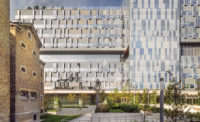Gebze, Turkey
People/Products
Set just off the axis of major highways connecting Anatolia and Europe, not far from a new airport in Istanbul, the strong, clear forms of the Anadolu Health Center project images of contemporary solidity to the surrounding countryside.
Located near Turkey’s main industrial zone, which provides an automatic roster of patients, the hospital and health complex serves the immediate geographic area near the Sea of Marmara. However, its reputation as a health-care facility, coupled with its architectonic amenities, is drawing a clientele from throughout the Middle East and eastern Europe. The medical center, affiliated with Johns Hopkins Medicine, based in Baltimore, sits on a hilltop in Gebze, on an open site bordered by protected woodland, an experimental olive grove, and a clear view to the sea.
The 209-bed acute-care hospital, medical office space, medical-related retail, and central plant form the initial investment in what will ultimately comprise a 2-million-square-foot campus outside Istanbul.
A green space at the core, complete with water features, distinguishes and links the three primary zones of the master plan, including medical, residential, and educational areas. Ultimately, the ambitious program will include a rehabilitation center, nursing home, and a hospice. In addition, plans call for a 240-student nursing-education school, a 360-student allied health-education school, a student dormitory, and a 150-room hotel to serve patients’ families and the residential needs of nurses.
The program’s complexity was compounded by the site’s seismic sensitivity: Because of the high level of activity in the area, located at the epicenter of the 1999 earthquake, the hospital would have to be designed for earthquake resistance, with a structure that could remain functional in the aftermath of a natural disaster. Foundations were required to rest 23 feet below grade, with waffle slabs capable of minimizing vibration levels in all surgical suites.
Organization of the large facility achieves clarity of function for the building occupants. Bright corridors enlivened by sunlight lead to vistas overlooking the nearby mountains.
Constructed of 32-by-32-foot spans with reinforced-concrete columns, the solid structural system permits flexibility and functionality of spaces. Waffle slabs of concrete reach between spans to disperse loads and minimize vibration for demanding surgical and treatment procedures. Polished local stone flooring lines spare interior corridors in primary public areas—a hard, reflective surface that mirrors the brightly lighted passageways. Patient rooms include a combination of residentially scaled furnishings in muted colors and modern health-care systems that taken together evoke a pleasant hotel room.







